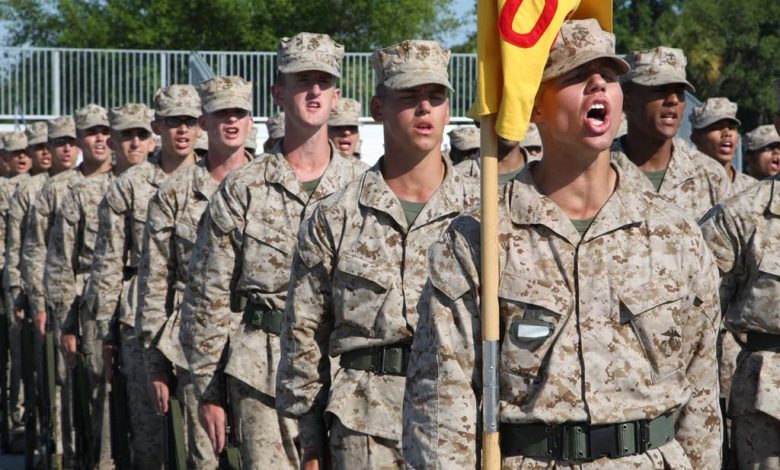Marines, Air Force on track for 2024 recruiting; Navy projected to miss

With three full months left in the fiscal year for military recruiting, the services already are developing a sense of whether they’ll make their target recruiting mission or end up short.
The Marine Corps has brought in more than 101% of its recruiting target for the year to date, up from 100% this time in 2023, and officials anticipate meeting annual recruiting goals once again.
The Navy, on the other hand, already is expecting to fall short of its target for a second consecutive year.
That’s according to military officials who testified before the Defense Advisory Committee on Women in the Services during the committee’s quarterly meeting on June 25 in Arlington, Virginia.
The Air Force and the Army, which have struggled in the past two years to meet recruiting goals, have indicated they’re on track to make mission.
While well-documented challenges remain, including lower propensity to serve, fewer qualified young people and a recently implemented health records system that has ramped up denials and delays, the services reported improvements in recruiting performance from 2023′s numbers as they work to adapt to new realities.
The Marine Corps already has brought in 12,924 contracts, above its year-to-date goal of 12,751, according to documents presented by Sgt. Maj. Allen Goodyear, the senior enlisted adviser for Marine Corps Recruiting Command.
This time in 2023, it was roughly even with its goal, having brought in 14,632 contracts in line with a goal of 14,632. The service finished fiscal 2023 with 33,223 enlisted accessions ― 21 contracts above its mission.
The Corps’ projected ability to meet or outpace its goal once again “is a result of planning factors allowing for a preponderance of accessions to occur during the summer shipping period which historically has higher quality recruits and mission success,” according to slides Goodyear shared with the committee.
The Navy, which has a higher enlisted accessions goal in 2024 than in 2023, also is making healthy progress.
The service has brought in 30,067 contracts of the 40,600 enlisted contracts it needs in 2024, or 74% of the total, according to data shared by the service’s chief recruiter, Master Chief Gerald Allchin.
This time in 2023 it had just secured 25,039 contracts of the 37,700 contracts it needed, or 66%, according to data shared at the meeting. The service ultimately missed its goal by 7,450 contracts.
The 5,000-person year-over-year increase puts the Navy in a more bullish position than it was in even earlier this spring, when Defense Department numbers showed it lagging behind the other services for the first half of the year.
Nonetheless, the Navy still projects it won’t be enough to meet this year’s goal.
“We are seeing significant increases year over year as you saw,” Allchin said. “Right now, we’re projecting a miss of around 4,200 for our active enlisted mission of about 40,600.”
The Air Force appears on pace to make its goal, with 19,321 enlisted accessions putting it just above the year-to-date goal of 19,262.
The Air Force Reserve also is on track to hit its target, said Chief Master Sgt. W. Frank Rawls, the Recruiting Service’s operations superintendent.
The service missed its accessions goal by 10% in 2023 in the first such shortfall since 1999.
Rawls credits the service’s 2024 success in part to a $100 million congressional plus-up in recruitment budgeting.
“And we seek to continue the momentum,” Rawls said, citing plans to increase enlistment bonuses and add nearly 200 more recruiters.
The Air Force, he said, also has requested $52 million in marketing funds for lead generation and outreach.
The Army, which in response to two years of missed accessions goals has overhauled its recruiting enterprise and slimmed down its targets, is nonetheless up year-over-year in raw numbers.
As of the end of April the Army had brought in 24,038 total new contracts, or 43.7%, of its goal of 55,000, according to Sgt. Maj. Danny Basham, the service’s sergeant major for analytics and production. In the same time in 2023 it had secured just 21,917 contracts, or 33.7%, of that year’s goal of 65,000.
“So production is increasing, and we’re figuring out the process,” Basham said.
While the most recent numbers show substantial ground that still needs to be made up, Basham maintained the service could meet this year’s lowered target.
“Our projections are showing that we will make our enlistment mission with a level of depth for the next fiscal year,” he said.
Even services with consistent recruiting performance like the Marine Corps, however, cited the difficulty of overcoming new challenges posed by MHS Genesis, the military’s new electronic health record.
The system’s seven-year rollout was completed in March. Because the system meticulously documents military applicants’ medical histories, it has necessitated a massive increase in waiver requests for conditions that otherwise might have gone unmentioned or ignored by recruiters.
Before the health system rollout, Goodyear said, getting 100 new Marine Corps contracts took 154 applicants; now it takes 181 applicants.
The number of medical waivers being submitted for applicants has more than doubled, creating processing delays.
The average time in military entry processing for recruits has increased from 10 days to 35 days, he said. And that means less time in the delayed entry program, where recruits get physical training and preparation ahead of shipping to boot camp.
With an average of 120 days in the delayed entry program compared with 162 days before MHS Genesis, the boot camp dropout rate has increased, he said, from 11% to 12%.
Other military representatives at the meeting, who were asked to present data about the impact of MHS Genesis, offered similar perspectives, even as they said they’re learning to work with the system and implementing staffing changes and policy updates designed to cut down on unnecessary delays and improve throughput.
Rawls emphasized that delays in initial processing can cause prospective recruits to second-guess their desire to serve. Amid ramped-up efforts to make recruiting mission in the Air Force, he said, service officials estimate between 3,000 would-be recruits and 4,000 would-be recruits in 2023 simply walked away from service amid long medical processing wait times.
Goodyear cited a similar effect.
“When delays and initial disqualifications occur, young Americans who want to serve are faced with uncertainty about their future,” Goodyear said. “Often, extended delays require these individuals to pursue a different career path based on the financial realities of life.”
Hope Hodge Seck is an award-winning investigative and enterprise reporter covering the U.S. military and national defense. The former managing editor of Military.com, her work has also appeared in the Washington Post, Politico Magazine, USA Today and Popular Mechanics.







